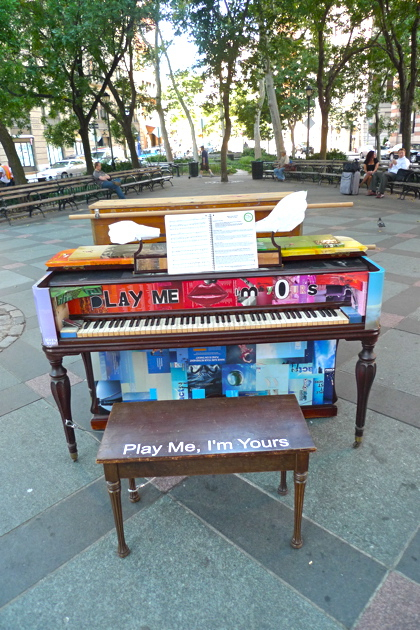Keys to the City
 “Play Me, I’m Yours,” the citywide public-art project that installed pianos around town, is over—that was too quick!—but I was curious about what it was like to work on the pianos. Camille Zamora, a co-founder of Sing for Hope (the organization behind the exhibit/event), put me in touch with Julie Pitman, the artist and designer—and Tribecan—who created the winged piano that was in Tribeca Park.
“Play Me, I’m Yours,” the citywide public-art project that installed pianos around town, is over—that was too quick!—but I was curious about what it was like to work on the pianos. Camille Zamora, a co-founder of Sing for Hope (the organization behind the exhibit/event), put me in touch with Julie Pitman, the artist and designer—and Tribecan—who created the winged piano that was in Tribeca Park.
Did you watch people play your piano? If so, did you introduce yourself?
Yes, I have watched many people play my piano. I was not interested in introducing myself. I enjoyed sitting back and listening, closing my eyes and relaxing, the freedom and lift. I like to be able to be anonymous in the city, to hide if you feel. It was always a new experience, which is what music does to me, moves me. Corny as it sounds, I was most often smiling while listening. The “project” had so many layers to me, all of which I never expected. I was so moved, especially when I was able to experience “the experience” it took on. It was a happening, and I was elevated to be a part of it all. A pure adrenaline rush, fabulous!
How and when did you get involved with Sing for Hope?
I have known Camille for three years. My husband and I were invited to a few Sing for Hope events. I was very moved by their mission and accomplishments. I believe in Camille and her goal and I was excited to be given a chance to “collaborate” with her. My husband is a laryngologist and became their “go to” voice doctor and recently joined their board. It’s a very talented roster of artists to be involved with.
What was the inspiration for your piano?
The inspiration was the collective montage of the city. The pastiche of the people; the effects and layering we have on each other—the color we add, how our lives intersect and intertwine and the trajectory it takes. I used magazines as a medium, words written about and by “us.” I also wanted to personify my piano via the wings and lips; a lifting of spirit. The purpose of the pianos being placed throughout the city was to give anyone and everyone a chance to play music: Lose yourself, be free, all amid the cacophonous backdrop.
How much time did you spend on it?
Approximately a week.
Camille mentioned the community of artists working on pianos. I’m not sure I have a question other than would you tell me about it?
It really struck me initially, walking into this large space [the old AT&T building on Sixth Avenue], with all of these “grand” pianos around me waiting to be chosen and “worked on.” You could sense they had a past… and a future, which excited me. I really fell for an art deco-ish piano but we were not sure how good it would sound initially. I so enjoyed showing up amongst other artists, with this common mission. It was a continual conversation about our work on the piano(s), and our lives, etc. The space was highly conducive to this in that there were no walls, and very bare bones; just our pianos, our medium, and us. I looked forward each day to my time spent working there. I really enjoyed hearing Fred tuning the pianos daily, it was lovely to work to his work. Often when we were working we’d accidentally lean on our keys, it became a John Cage score or such, very moving.
Do you know where the piano will go afterward?
We are looking for an underserved local school.



















We are so proud of you and how you related to this wonderful project that has so many dimensions and was so well run. Your theme and your feelings as articulated in this interview make the onlookers feel the music. Mucho amore
That IS really great. I heard about some pianos being around for everyone to play.. I love the funky look you capped onto it! Very creative.